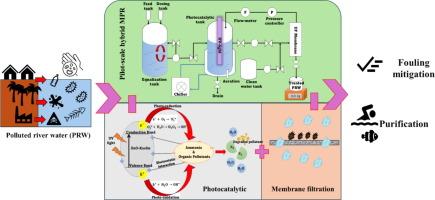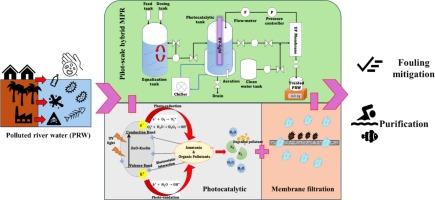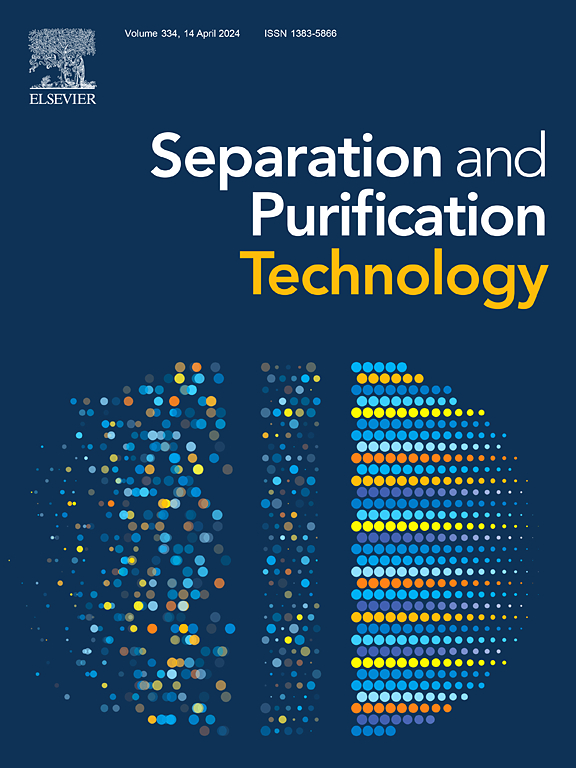Improving membrane fouling via high phyllosilicate properties of ZnO-Kaolin in pilot-scale hybrid membrane photocatalytic reactor (MPR) for superior river water treatment
IF 8.1
1区 工程技术
Q1 ENGINEERING, CHEMICAL
引用次数: 0
Abstract
A study evaluated a pilot-scale hybrid membrane photocatalytic reactor (MPR) using ZnO-Kaolin to treat polluted river water. ZnO-Kaolin was successfully synthesised and characterised using various methods, such as X-ray diffraction (XRD), fourier-transform infrared (FTIR), and field emission scanning electron microscopy (FESEM). XRD and FTIR analyses verified the purity of ZnO-Kaolin, showing no impurities, while FESEM revealed ZnO nanoparticle growth on kaolin surfaces. Additionally, the ZnO-Kaolin band gap was shifted, demonstrating enhancement of photo-degradation efficiency. Optimisation identified pH 5 as the most effective condition for treating the polluted Sembrong River via pilot-scale hybrid MPR integrated with ZnO-Kaolin, achieving significant removal of ammoniacal nitrogen (85.71 %), chemical oxygen demand (91.53 %), biochemical oxygen demand (84.93 %), and suspended solids (99 %). This innovative system also regulated water quality parameters, enhancing pH to 6 and dissolved oxygen to 6.3 mg/L while minimising membrane fouling. This innovative approach has promising potential for commercial-scale water pollution control.


在中试规模的混合膜光催化反应器(MPR)中,通过 ZnO-Kaolin 的高植硅酸盐特性改善膜结垢,以实现卓越的河水处理效果
一项研究评估了使用氧化锌-高岭土处理污染河水的中试规模混合膜光催化反应器(MPR)。成功合成了 ZnO-Kaolin,并使用多种方法对其进行了表征,如 X 射线衍射 (XRD)、傅立叶变换红外 (FTIR) 和场发射扫描电子显微镜 (FESEM)。X 射线衍射(XRD)和傅立叶变换红外光谱(FTIR)分析证实了氧化锌高岭土的纯度,没有发现杂质,而场发射扫描电子显微镜(FESEM)则揭示了氧化锌纳米颗粒在高岭土表面的生长情况。此外,氧化锌-高岭土的带隙发生了偏移,表明光降解效率有所提高。通过优化,确定 pH 值为 5 是通过中试规模混合式 MPR 处理受污染的森布龙河的最有效条件,该系统与 ZnO-Kaolin 集成,可显著去除氨氮(85.71%)、化学需氧量(91.53%)、生化需氧量(84.93%)和悬浮固体(99%)。这一创新系统还能调节水质参数,将 pH 值提高到 6,将溶解氧提高到 6.3 mg/L,同时最大限度地减少膜堵塞。这种创新方法具有商业规模水污染控制的巨大潜力。
本文章由计算机程序翻译,如有差异,请以英文原文为准。
求助全文
约1分钟内获得全文
求助全文
来源期刊

Separation and Purification Technology
工程技术-工程:化工
CiteScore
14.00
自引率
12.80%
发文量
2347
审稿时长
43 days
期刊介绍:
Separation and Purification Technology is a premier journal committed to sharing innovative methods for separation and purification in chemical and environmental engineering, encompassing both homogeneous solutions and heterogeneous mixtures. Our scope includes the separation and/or purification of liquids, vapors, and gases, as well as carbon capture and separation techniques. However, it's important to note that methods solely intended for analytical purposes are not within the scope of the journal. Additionally, disciplines such as soil science, polymer science, and metallurgy fall outside the purview of Separation and Purification Technology. Join us in advancing the field of separation and purification methods for sustainable solutions in chemical and environmental engineering.
 求助内容:
求助内容: 应助结果提醒方式:
应助结果提醒方式:


